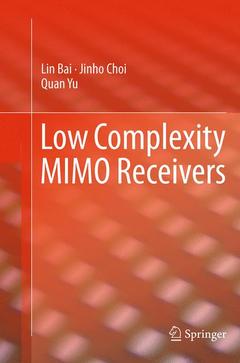Description
Low Complexity MIMO Receivers, Softcover reprint of the original 1st ed. 2014
Lattice Reduction based Approaches
Authors: Bai Lin, Choi Jinho, Yu Quan
Language: English
Subjects for Low Complexity MIMO Receivers:
Keywords
Coordinated Multipoint (CoMP); Interference Alignment; Iterative Receiver; Lattice Reduction; MIMO Detection; Multiple-Input Multiple-Output (MIMO); Multiuser MIMO systems; Orthogonal Frequency Division Multiple Access (OFDMA); Successive Interference Cancellation (SIC); Underdetermined MIMO
Approximative price 158.24 €
In Print (Delivery period: 15 days).
Add to cartPublication date: 09-2016
Support: Print on demand
Approximative price 158.24 €
In Print (Delivery period: 15 days).
Add to cartPublication date: 03-2014
296 p. · 15.5x23.5 cm · Hardback
Description
/li>Contents
/li>Biography
/li>Comment
/li>
Dr. Lin Bai is an Associate Professor at School of Electronic and Information Engineering, Beihang University (University of Aeronautics and Astronautics, BUAA), Beijing, China.
Prof. Jinho Choi researches and teaches at Gwangju Institute of Science and Technology in South Korea.
Prof. Quan Yu is a Research Fellow at the Institute of China Electronic System Engineering Corporation. He is an Academician of Chinese Academy of Engineering (CAE).
Introduces the use of lattice reduction in MIMO receiver design
Examines implementation of MIMO hardware and lattice reduction techniques
Investigates LR-based MIMO iterative receiver from a stochastic aspect
Includes supplementary material: sn.pub/extras
These books may interest you

Low Complexity MIMO Detection 105.49 €

Low Complexity MIMO Detection 105.49 €


